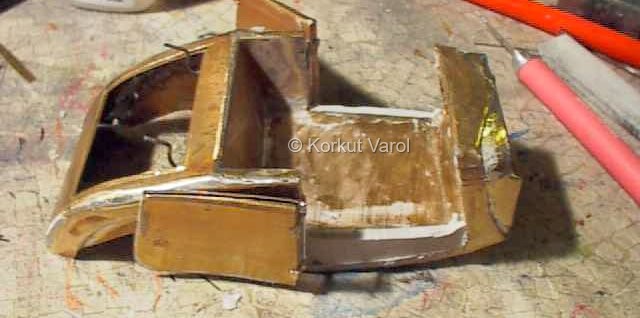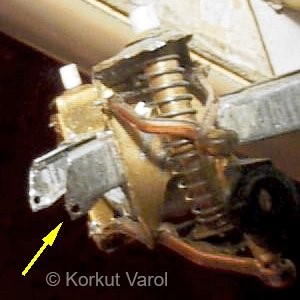| The
cavities
between the doors and the floorpan skirts had to be filled with
polyester
putty, so that the floor would end where it met the door. To prevent
sticking
to the door, a piece of double-sided transparent sticking sheet was
applied
on the inside of the door without removing the protective slippery
sheet.
Then adequate putty was applied and the doors closed, defining the
final
shape of the putty. |

|
| Excess putty was trimmed with hand
filing.
Now the floorpan is complete from door to door. |

|
| The template for the hood was traced
on
a transparent paper, then transferred to a cardboard. Primary bending
of
the cardboard and making retouches to the contours were necessary till
the proper development profile was reached. |

|
| The hood is designed as a unitary
part
with the front grille and to be tilted forward. The sides of the hood
were
given a custom cutout profile and tested on the model. then the
development
was carried on to the brass sheet. |

|
 |
| The center line embossing was given
to
the metal as was done with the doors. That is, three consequent
alternating
close bends. |

|
 |
| The metal hood was put on the model
after
primary bending. Irregularities were overcome by re-bending and
blending
in by hand. Pliers or other tools may also be used for bending the hood
curves, but then there will be tool marks left on the metal which will
require further machining or putty treatment. |

|
| The mismatches in the levels of the
mating
edges of the doors and the body were done with the application of
polyester
putty and filing down to the same level. |

|
| The necessary places under the boot
lid
were also treated with polyester putty so that they would look unitary
when sanded. |

|
| The front grille was glued to the
hood
with 5-minute epoxy. |

|
| A general view showing that putty was
applied almost all over except for the surface of the hood. |

|
| The hood was put on the chassis, and
the
front end profile was cut in parallel with the front grille
inclination. |

|
| The bottom fronts of the chassis were
opened up with pliers so that the side plane of the chassis was
extended
to front lower part. Then one hole 1mm dia. were drilled on each side.
Next, this latter formed parts were bent back again, but with an angle
with the chassis at first, then given the next opposite bend to form a
drilled bracket hanging down the inner sides of the chassis. |
 ... ...
|
| Two L-shaped brackets were made from
brass
sheet and glued with 5-minute epoxy from the inside to the hood. Then
the
hood was placed on the chassis again, matching with the body, and
secured
with masking tape to preserve relative positions. Then the holes were
drilled
on the hood brackets using the holes on the chassis as drilling
jigs. |

|
| This is how it looked after the holes
were drilled. To smoothen the level difference of the hood and the
pivoting
bracket, putty was applied and sanded down to smooth transition. |

|

|
 
|

